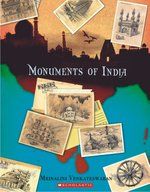
The origins of the word ‘monument’ have to do with remembrance, whether that refers to remembrance of an event, a person, or our common past through its material remains. A monument is thus usually considered the most visible and recognizable marker of a people or culture, and perhaps indicates who we are, through what we choose to remember.
Just as with people however, a monument too has multiple layers to its identity. So Itmad-ud-Daulah’s tomb in Agra is not just a Mughal monument. Rather, it is a mausoleum/ tomb, constructed by a member of the Mughal dynasty, in an architectural style that is both Islamic as well as Mughal. It is linked to the Taj Mahal both because of architectural as well as decorative affinities.
None of this is new to a professional or an enthusiast, but most history students in Indian schools are rarely encouraged to imagine anything other than lists of names and dates as being relevant to either their lessons or lives. Another point worth considering is that since Indian parental culture tends to encourage reading associated with schoolwork, there are numerous facts-and-figures based books in the market, and dozens on Indian monuments alone. They all veer towards a classification prioritising community-based stylistic affiliations, so one usually has lists that read of Hindu, Buddhist, Jain, Islamic, Colonial &/ or Christian, etc. monuments, which serve to emphasise one or at most two aspects of a monument’s identity.
Monuments of India attempts to address several of these issues, by approaching each of the fifty monuments discussed in its pages from all sorts of angles. To begin with, monuments are classified by function rather than communal styles – so sections deal with places of residence, government & defence; public & commemorative buildings/ structures; places of worship, and mausoleums. The possibility that a monument might fulfil multipleroles is also explored. With each section, monuments have been selected keeping in mind chronology and so as to cover as wide a range as possible. So for instance, ‘Places of Residence’ includes the rock shelters of Bhimbetka as well as Rashtrapati Bhavan, with many other possibilities of richness and scale in between. Implicit in such a selection is also a challenge to the common assumption that a monument necessarily must be built by human hands – Bhimbetka for instance is only adapted for human use but is an important marker of the development of human homes.
Each section is prefaced with a map and timeline that locates every monument within that section both spatially and chronologically, especially with relation to one another. Sites of universal significance (World Heritage) are additionally denoted. The entries contain a melange of information – building history, about the builder/ patron/ architect, the architectural style, function, their functional, stylistic, dynastic and/ or any other links with other monuments, as well as stories (true or otherwise!) connected to them. Basic concepts about types of buildings and architectural styles for example, are also introduced throughout the book along with ‘clues’ to recognising them. The book thus aims not only to provide multiple perspectives on each monument, but ideally also encourages a similar approach for any student reading about or visiting one.
Monuments of India was published by Scholastic Books in 2009.
